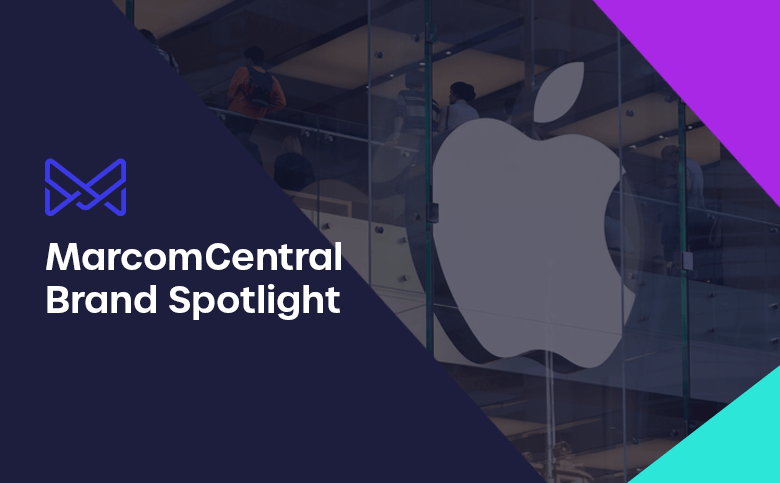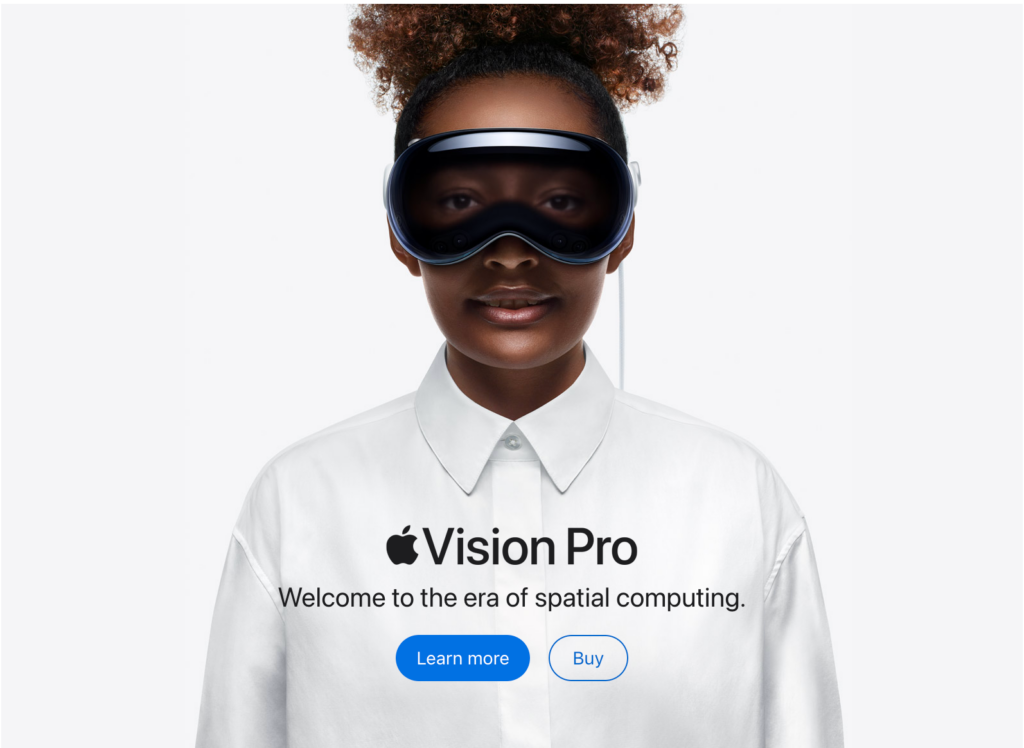Get news, updates, and insights delivered straight to your inbox.
Apple’s Marketing: 8 Key Strategies and Famous Campaigns

Apple Inc. is one of the top companies in the world and one of the most recognizable. Whether you are team iPhone or Android, Mac or PC, you could most likely recognize an Apple product when presented with one, thanks to the well-known Apple logo and the trademark sleek design.
Apple has been a long-standing powerhouse in the computing and information technology industries, due in part to its effective marketing strategies and famous brand campaigns. They have helped Apple catch customers’ attention, creating value and encouraging consumers to regularly seek the most updated devices. This case study explores Apple’s marketing strategy and how it has led to the company’s widespread success.
Key Strategies
Apple Inc. was founded in 1976 by Steve Jobs and Steve Wozniak. Almost immediately the cofounders began inventing and selling technology products under Apple Inc. (previously Apple Computers, Inc.) The earliest product was a microcomputer and then came the Mac computers, iPhones, iPods, and more. These innovative products and Apple’s key marketing strategies have turned Apple into a globally recognizable brand.
According to Forbes, Apple Inc. is the second-largest company in the world, based on market capitalization. For Apple to reach this heightened level of success, they had to employ a range of marketing techniques, from multi-channel marketing to sleek and simple packaging. Apple has been the recipient of the CMO Survey Award for Marketing Excellence for ten consecutive years, proving the high quality and effectiveness of its marketing efforts. Here are some key marketing strategies that have contributed to this success:
1. Multichannel Marketing Model
To be successful at marketing a product or service, businesses should use a marketing mix, or multiple channels to target customers. Multichannel marketing employs several routes to target customers and bring their attention to a product or service. With customers engaging with brands via different media platforms, it’s typically not enough to only market a product or service with one channel. This is why Apple uses multiple channels to both promote and sell its products.
For promotion, Apple employs television and print advertising, website ads, social media ads, sales, and more to draw customers from many different walks of life. For selling their products, Apple uses both online and offline distribution channels. Customers can purchase Apple products directly from Apple retail stores or through their website, from telecom companies like Verizon or AT&T, or authorized reseller online stores like Amazon or eBay. The convenience of accessing Apple products in person and online can make customers more likely to buy them.
Imagine if the only way to get an iPhone was to visit an Apple store and purchase it in person. This would plummet Apple’s sales, as even people who wanted an iPhone may not be able to access it at their retail stores. According to a 2022 report from CIRP (Consumer Intelligence Research Partners), only around 24% of iPhones purchased in the U.S. were sold directly by Apple. If Apple didn’t have deals with wireless companies to sell their products, they wouldn’t have nearly as wide of a reach. By offering customers multiple ways to buy their products, Apple has set its company up for marketing success.
2. Less Is More
One of Apple’s main advertising strategies is to keep its marketing and products straightforward. This simplistic approach was started by co-founder Steve Jobs, who said “The way we’re running the company, the product design, the advertising, it all comes down to this: Let’s make it simple. Really simple.” True to this strategy, Apple’s product designs and advertisements are minimalist to intrigue customers without overwhelming them.
“Simple can be harder than complex: You have to work hard to get your thinking clean to make it simple. But it’s worth it in the end because once you get there, you can move mountains”
In Apple’s marketing, the company avoids showing pricing, slogans, long chunks of text or speech, and technical language because they can confuse or turn off customers. Apple’s slogan is “Think Different,” but it’s often not used. This is because Apple simply uses its famous bitten apple logo in its advertisements. The logo speaks for itself and instantly lets people know whose ad they’re seeing.
In terms of product design, Apple specifically models its products to have a sleek appearance with neutral colors, simple names, and trademarked Apple logos. Whether it’s a MacBook or an iPhone, all Apple’s products are designed to be user-friendly, easy to use, and not overly technical so they can appeal to the widest audience. When high-tech details are provided for products online, they are found below the fold of the Apple website, since they usually don’t appeal to Apple’s main target audience. Apple focuses on the functionality of its products, rather than the complexity.
Using minimalist, simple techniques in marketing and products helps potential customers take notice of them without being overwhelmed with too many details at once. This is why keeping their marketing strategy simple has been beneficial for Apple for decades.
Source: https://www.apple.com/
3. Understanding and Appealing to the Target Market
Another successful part of Apple’s marketing strategy is catering their products to their target markets. Since Apple’s establishment, they have narrowed down the target audience they want their products to reach. However, each product’s target audience is slightly different.
Apple’s target audience generally consists of middle- to upper-class individuals who are willing to pay more for an innovative product and quality user experience. They are often younger to middle age and located in America, Europe, or China. Advertisements often showcase exciting new features in the latest models of iPhones, AirPods, and more, which catch the eye of their target audience. By demonstrating the unique capabilities of the newest product, Apple creates value for its target audience, often generating more awareness and desire for these offerings.
Apple’s physical and digital marketing also focuses on the people using the products, not the products themselves. This tactic can create a connection with customers and encourage them to buy the product in the ad. By focusing on their target audience in their marketing strategy, Apple has been successful in creating a loyal customer base that will continue to use its products.
4. Global Brand Recognizability
As mentioned above, the Apple brand and its products are recognized globally. Apple has one of the most famous logos in the world, identifiable even across different countries and continents. The logo is simple—an apple with a bite out of it. It’s found on the back of their products, on packaging, in commercials, and more. The bitten apple logo was designed in 1977 and has remained largely unchanged since then, besides changes in the color. It helps that the logo is a simple object that shares its name with the brand’s. So, seeing the Apple logo can
subconsciously communicate the brand. It’s not just this strong brand identity that has made Apple known worldwide. The company is present in more than 150 countries across the globe.
To appeal to global markets, Apple uses segmented marketing tactics that consider the nuances and cultural differences in different countries. For example, when marketing to Chinese customers, Apple may employ different kinds of colors, slogans, scenes, and words than they would when marketing to American customers. This is to avoid offending customers and to ensure each campaign is tailored for success.
Having a globally recognizable brand is hugely beneficial, as the more people that know about a brand, the more people there are to buy their products. As one of the most well-known brands in the world, Apple is set up for success on this front.
5. Creating the Ultimate Ecosystem
Although Apple’s products and marketing are straightforward, they don’t let innovation fall by the wayside. Instead, Apple consistently focuses on innovating new products and features to create a complete network of products and services. This network is known as the Apple ecosystem. It includes products like Mac computers, iPhones, iPads, and Apple Watches, services like ApplePay and Apple TV+, and all the apps that run on them. The Apple ecosystem offers a wide range of features for those who use it, including:
- Paying digitally with your iPhone or Apple Watch using ApplePay
- Monitoring health, sleep, and steps by wearing an Apple Watch
- Controlling home electronics and alarm systems via apps on iPhones or Apple Watches
- Sending messages and files over Bluetooth to other Apple devices with the AirDrop feature
- Watching movies, TV shows, and more with an Apple TV+ subscription
- Finding luggage, keys, and other misplaced items with AirTags
- Controlling music, searches, and more with a smart speaker called the HomePod
- Streaming music, music videos, and more with Apple Music or buying them on iTunes
- Buying apps to play games, stream videos and music, and more through the App Store
- Storing plane tickets, credit cards, hotel key cards, and concert tickets in Apple Wallet
This ecosystem means Apple’s products are intertwined. In some cases, you can’t use one without the other. For instance, you can’t use an Apple Watch without first having an iPhone. For those who want an Apple Watch but don’t yet have an iPhone, the marketing for Apple Watches alone can encourage them to purchase an iPhone. This ecosystem is part of what differentiates Apple from competitors like Microsoft.
6. Emphasis on Customer Experience
Creating a satisfactory customer experience plays a large role in Apple’s marketing strategy. This includes everything from browsing and shopping in-store for products to buying the product and setting it up. Apple focuses on every detail when designing its products, website, and stores to ensure every experience is as easy as possible. Some of the ways Apple does this include:
- Using neutral colors and minimalist designs in stores
- Having welcoming employees available as soon as you enter the store
- Designing products to look sleek, easy to set up, and user-friendly
- Making the Apple website easy to navigate and product descriptions digestible
- Providing high-quality customer service via support text/chat
Another way Apple enhances the customer experience is by using customer-based metrics to measure their success, rather than sales. Apple uses a customer-based metric called the Net Promotor Score (NPS), which measures how willing customers are to recommend a company’s products to others. This score lets the company know what is working and what they should change.
By focusing on the customer experience, Apple has been able to gain a loyal following of customers and users. More than 90% of customers who have an iPhone plan to get another, according to a survey from Bloomberg Intelligence. This deep customer and brand loyalty is partially because of the excellent customer experience Apple aims to provide its customers.
7. Pricing Strategy
Another marketing tactic in Apple’s repertoire is its control pricing strategy. Apple’s products rarely, if ever, go on major sale and they use premium pricing. The company utilizes a minimum advertised price, or MAP, to price its products—which stops other sellers from pricing Apple products below the MAP. Apple purposely keeps the prices higher for its products to signify their quality, luxuriousness, and innovativeness. Instead of trying to recruit new customers with lower prices, Apple focuses on the loyal customers it already has who will likely repurchase these products.
Although Apple still wants to be seen as a luxury brand, they don’t want to miss out on middle-class customers who may be on the verge of being able to afford a product. For this reason, Apple offers an Apple Card, which is a titanium credit card that provides cash back and a monthly installment feature. By allowing customers to pay in installments, they may be more likely to purchase a product.
8. Sustainability
As a global company, Apple may feel more inclined to consider sustainability, as more eyeballs monitor their efforts and pledge loyalty to the brand. These initiatives include Apple’s commitment to carbon neutrality in corporate emissions and its goal of being 100% carbon neutral for its products and supply chain by 2030. Apple also has a carbon-neutral Apple Watch series and uses eco-friendly practices in their packaging.
By focusing on sustainability, Apple ensures its brand values can show through—cementing them as a company with an eco-conscious mindset. This can lead to an improved brand image and greater customer satisfaction, giving them a competitive advantage over other brands that aren’t as sustainable. It can also lead to stronger relationships with stakeholders.
Most Notable Apple Ads Ever
Now that you’re familiar with the marketing techniques Apple uses in its strategy, you can learn more about how marketing teams have put them into action for different campaigns. Review some of the most famous Apple ads throughout the years and the impact they’ve had on consumer perception and overall marketing efforts.
1. 1984 (1984)
The most famous Apple ad is also the first to air during a major television event. It ran during Super Bowl XVIII in 1984 and was created to announce the Macintosh Computer. This ad was directed by Ridley Scott and inspired by the science fiction fantasy novel, 1984, by George Orwell.
It features a dystopian scene with people dressed the same, moving the same, and heading towards a screen with a “Big Brother” persona. Suddenly, a young female athlete runs toward the screen with a sledgehammer, as guards chase her. She throws it at the screen, hits it, and causes it to explode. Then appears the text: “On January 24th, Apple Computer will introduce Macintosh. And you’ll see why 1984 won’t be like 1984.”
What Made It:
1984 is one of Apple’s most iconic ads and one of the most acclaimed commercials ever created. It signaled the beginning of the personal computer era, led by Apple. By showing the girl standing up against conformity, presumably symbolizing Apple or Mac, it casts Apple as an innovator in the industry. It also suggested Apple was bringing something that would change society.
2. The Pencil Test (1988)
Another famous Apple ad is The Pencil Test from 1988, which was produced in collaboration with experienced animators. Some of the animators who worked on this commercial even went on to found or work for Pixar. This ad is a short, animated film that shows a pencil trying to get back inside a computer’s interface, with the assistance of other office supplies.
What Made It:
This ad demonstrates how users can make animations with the software on Apple Macintosh II computers. Computer animation was not as widespread at this point, and The Pencil Test helped showcase it was possible, especially with an Apple computer.
3. Mac vs Ordinary PC (1993)
Mac vs. Ordinary PC is another famous Apple ad, which compares the Macintosh personal computer with an ordinary PC. It showcases the Macintosh as easy to use with advanced features—all costing less than a PC. The ad ends with a simple tagline: “Macintosh: It does more. It costs less. It’s that simple.”
What Made It:
This ad helped establish the Macintosh computer as the more modern and affordable option over a PC. Although Macs often cost more than PCs today, they have still kept their reputation as innovative and contemporary.
4. Think Different/Here’s to the Crazy Ones (1997)
Another one of Apple’s most famous ad campaigns is the “Think Different” ad, also known as “Here’s to the Crazy Ones”. Released in 1997, this commercial was filled with black-and-white footage of famous activists, creatives, leaders, and other icons. In the background, a poem called “Here’s to the Crazy Ones” is read by actor Richard Dreyfuss.
The poem begins with “Here’s to the crazy ones. The misfits. The rebels. The troublemakers. The round pegs in the square holes. The ones who see things differently.” It continues and eventually ends with “While some see them as the crazy ones, we see genius. Because the people who are crazy enough to think they can change the world, are the ones who do.”
What Made It:
In the 90s, Apple products were often thought of as those for creative applications, not business and tech. Apple chose to embrace this image and make an ad that shows how creative people are the ones who make change in the world, rather than those who stick to the status quo. It pushed customers to “think differently” about both Apple’s products and the world. It also helped cement the idea for Apple’s slogan, “Think Different.”
5. Silhouettes (2003)
This Apple ad is an example of gearing marketing toward one segment of the target audience. In this case, younger generations. The series of ‘Silhouettes’ advertisements were to showcase iPods and iTunes and were specifically designed to appeal to younger demographics. There was no talking or long text—simply good music, bright backgrounds, dancing silhouettes wearing white earbuds, and the product name at the end.
What Made It:
The Silhouettes ads ran for more than two years—emphasizing the success of them. They purposely highlighted the portable design of the iPod and used different types of music to appeal to fans of various genres. The ads were also simple and memorable, so people’s attentions were captured just in time to see the Apple brand name appear.
6. Get a Mac (2006)
This next ad campaign ran throughout the mid-2000s with 66 different commercials. The Get a Mac campaign came out when the Mac vs. PC debate was in full force and Mac sales were declining. It features actors Justin Long and John Hodgman as a Mac and PC, respectively, and in each commercial, they compare each other’s features. The ads always showcase how simple yet innovative Macs are, while teasing that PCs are complicated and not as functional.
What Made It:
This campaign was very memorable and successful, running over four years. The ads helped position Mac over PC for a variety of reasons and promoted their focus on innovation and simplicity. After the first year of the campaign, Apple saw sales figures jump 39% compared to the previous year.
7. There’s an App for That (2009)
This next campaign is for Apple’s famous iPhone, which came with a new slogan for the device: “There’s an app for that.” This ad features a man holding an iPhone and discussing the various apps available on an iPhone—like weather, calorie counters, and parking spot locators. This commercial was designed to demonstrate how the iPhone is capable of so much more than an average phone.
What Made It:
By showcasing Apple’s innovation with the apps on the iPhone, they both intrigued customers and created customer value for their latest product. This ad also marked how business models and product designs can evolve to meet the customers’ needs and wants.
8. Misunderstood (2013)
This famous Apple ad was so memorable and well-executed that it won a Creative Arts Emmy for ‘Outstanding Commercial’. It debuts in the Christmas season and features a young man visiting his family for Christmas. He seems to have his head buried in his iPhone the entire time. However, the commercial eventually shows a family video he has been filming the whole time.
What Made It:
This ad creates an emotional connection and experience with customers. It doesn’t focus on the product, but rather on the people. At the same time, Apple also showcased the capabilities of iPhones for filming and creating videos.
9. 911 (2022)
This recent Apple Watch ad is memorable and attention-grabbing. It features three harrowing 911 calls from people in emergencies. As the ad ends, it is revealed that each person was saved because they were wearing an Apple Watch and able to call 911 for help.
What Made It:
This ad showcases the value of an Apple Watch. This commercial encourages people to consider an Apple Watch by making an emotional appeal. It indicates how these real-life situations could happen to anyone and that the Apple Watch is more than just innovative—it may save lives.
Update Your Marketing Strategy With MarcomCentral
Apple has established itself as one of the biggest and most recognized companies in the world. Their effective marketing strategies are part of the reason for Apple’s success. If your business could use marketing solutions to help it succeed, trust in the expertise at MarcomCentral. Our marketing platform supports businesses across various industries and might be what your business needs to thrive. Contact us today or request a demo to learn more about our marketing solutions and platform.





